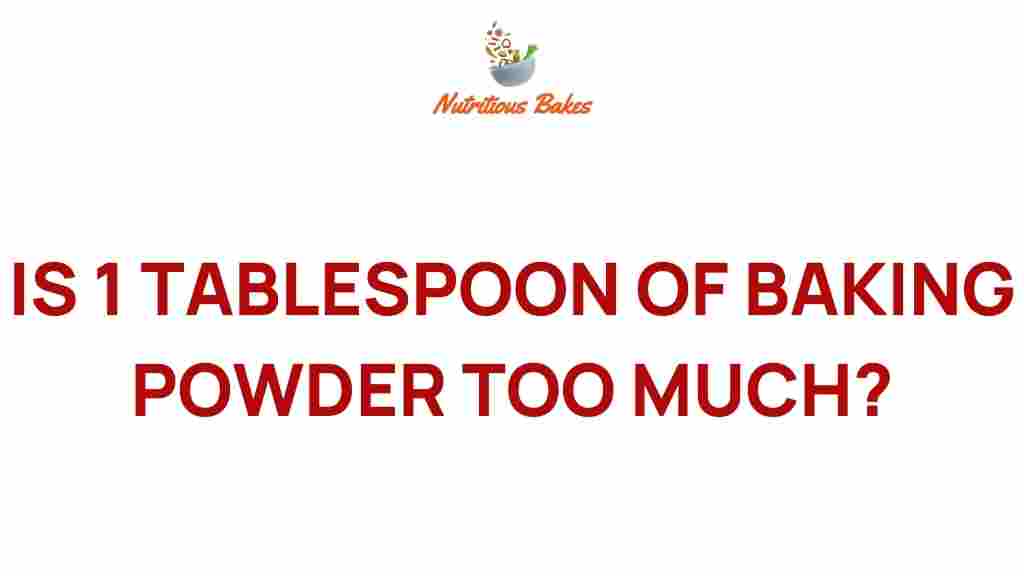Is One Tablespoon of Baking Powder Excessive for Your Baked Goods?
Baking powder is a crucial ingredient in many baking recipes, acting as a leavening agent that helps baked goods rise. However, the question remains: is one tablespoon of baking powder excessive for your baked goods? In this article, we will explore the baking science behind baking powder, ingredient ratios, and how to achieve perfect results in your culinary adventures.
Understanding Baking Powder
Baking powder is a chemical leavening agent that contains a combination of an acid and a base, along with a moisture-absorbing agent, such as starch. It works by releasing carbon dioxide gas when it comes into contact with moisture and heat, leading to the desirable rise in baked goods. Understanding the food chemistry of baking powder is essential for effective baking.
The Role of Ingredient Ratios
When it comes to baking, ingredient ratios are critical. Using the correct amount of baking powder is key to achieving the right texture and flavor. Typically, the standard ratio is:
- 1 teaspoon of baking powder per 1 cup of flour for most recipes.
- For recipes with denser ingredients (like whole wheat flour), you may need up to 1.5 teaspoons per cup.
So, is one tablespoon (which equals 3 teaspoons) excessive? Let’s find out through a deeper examination of cooking tips and culinary techniques.
How Much Baking Powder is Too Much?
Using too much baking powder can lead to several issues in your baked goods:
- Bitter Taste: Excess baking powder can impart a bitter flavor, overshadowing the sweetness of your treats.
- Unpleasant Texture: Over-leavened baked goods may become overly airy and collapse, losing their structure.
- Color Changes: Cakes and breads may turn overly brown due to excessive baking powder.
As a rule of thumb, using more than 1 tablespoon of baking powder for every 2 cups of flour is generally considered excessive. This is where baking science and careful measurement come into play.
Common Baking Recipes and Their Baking Powder Needs
Different baked goods require different amounts of baking powder. Here are some common recipes and their recommended baking powder amounts:
- Cakes: 1 to 1.5 teaspoons per cup of flour.
- Muffins: 1 to 2 teaspoons per cup of flour.
- Quick Breads: 1 to 2 teaspoons per cup of flour.
- Pancakes: 1 to 1.5 teaspoons per cup of flour.
Using these ratios helps ensure your baked goods rise appropriately without the negative effects of too much baking powder.
Step-by-Step Guide to Using Baking Powder
To use baking powder effectively in your baking experiments, follow these steps:
- Measure Accurately: Use a dry measuring cup and level off the baking powder with a knife. Avoid scooping directly from the container, as it can lead to excess.
- Combine with Dry Ingredients: Mix baking powder thoroughly with flour and other dry ingredients to ensure even distribution.
- Check Expiration Date: Old baking powder can lose its potency. Always check the expiration date before use.
- Use Immediately: Once mixed with wet ingredients, bake as soon as possible to capture the gas released by the baking powder.
Kitchen Experiments with Baking Powder
One of the joys of baking is experimentation. Here are some fun kitchen experiments to try with baking powder:
- Adjusting Ratios: Experiment with different ratios of baking powder in your favorite recipes to see how it affects the final product.
- Substitutions: Try substituting baking powder with baking soda and an acid (like vinegar or lemon juice) to observe the differences.
- Temperature Trials: Bake the same recipe at different temperatures to see how it affects the rise and texture of your baked goods.
These experiments can enhance your understanding of food chemistry and improve your baking skills.
Troubleshooting Baking Powder Issues
Sometimes, even seasoned bakers face issues when baking with baking powder. Here are some common problems and their solutions:
- Problem: Cakes are flat.
- Solution: Check the freshness of your baking powder and ensure you used enough based on the flour amount.
- Problem: Bitter taste in baked goods.
- Solution: Reduce the amount of baking powder used and taste your batter before baking.
- Problem: Overly dark crust on baked goods.
- Solution: Lower the oven temperature slightly or reduce the baking powder.
Conclusion
In conclusion, one tablespoon of baking powder can be excessive for your baked goods, depending on the recipe and ingredient ratios used. Understanding the baking science behind this important ingredient is essential for successful baking. It’s all about balance and precision.
Whether you’re a novice or an experienced baker, adhering to recommended measurements while experimenting with different culinary techniques can enhance your baking skills. Remember to make use of accurate measurements, check the freshness of your ingredients, and enjoy the process of creating delicious treats!
For more tips on baking and cooking, visit our cooking tips page. And for a deeper dive into baking science, check out this external resource on food chemistry.
This article is in the category Tips and created by NutritiousBakes Team
